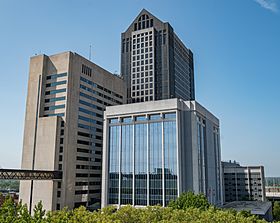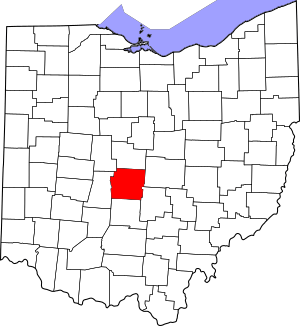Franklin County, Ohio facts for kids
Quick facts for kids
Franklin County
|
||
|---|---|---|

|
||
|
||
| Etymology: Benjamin Franklin | ||

Map of Ohio highlighting Franklin County
|
||
| Country | United States | |
| State | Ohio | |
| Region | Central Ohio | |
| Founded | April 30, 1803 | |
| Area | ||
| • Total | 544 sq mi (1,410 km2) | |
| • Land | 532 sq mi (1,380 km2) | |
| • Water | 11 sq mi (30 km2) | |
| Population
(2020)
|
||
| • Total | 1,323,807 | |
| • Estimate
(2021)
|
1,321,414 |
|
| • Density | 2,433.5/sq mi (939.6/km2) | |
| Time zone | UTC−5 (North American EST) | |
| • Summer (DST) | UTC−4 (EDT) | |
| Congressional districts | 3rd, 12th, 15th | |
Franklin County is a county in the U.S. state of Ohio. As of the 2020 census, the population was 1,323,807, making it the most populous county in Ohio. Most of its land area is taken up by its county seat, Columbus, the state capital and most populous city in Ohio. The county was established on April 30, 1803, less than two months after Ohio became a state, and was named after Benjamin Franklin. Franklin County originally extended north to Lake Erie before being subdivided into smaller counties. Franklin County is the central county of the Columbus, OH Metropolitan Statistical Area.
Franklin County, particularly Columbus, has been a centerpiece for presidential and congressional politics, most notably the 2000 presidential election, the 2004 presidential election, and the 2006 midterm elections. Franklin County is home to one of the largest universities in the United States, Ohio State University, which has about 60,000 students on its main Columbus campus.
It shares a name with Franklin County in Kentucky, where Frankfort is located. This makes it one of two pairs of capital cities in counties of the same name, along with Marion Counties in Indiana and Oregon.
Contents
History
On March 30, 1803, the Ohio government authorized the creation of Franklin County. The county originally was part of Ross County. Residents named the county in honor of Benjamin Franklin. In 1816, Franklin County’s Columbus became Ohio’s state capital. Surveyors laid out the city in 1812, and officials incorporated it in 1816. Columbus was not Ohio’s original capital, but the state legislature chose to move the state government there after its location for a short time at Chillicothe and at Zanesville. Columbus was chosen as the site for the new capital because of its central location within the state and access by way of major transportation routes (primarily rivers) at that time. The legislature chose it as Ohio’s capital over a number of other competitors, including Franklinton, Dublin, Worthington, and Delaware.
On May 5, 1802 a group of prospective settlers founded the Scioto Company at the home of Rev. Eber B. Clark in Granby, Connecticut for the purpose of forming a settlement between the Muskingum River and Great Miami River in the Ohio Country. James Kilbourne was elected president and Josiah Topping secretary (McCormick 1998:7). On August 30, 1802 James Kilbourne and Nathaniel Little arrived at Colonel Thomas Worthington's home in Chillicothe, Ohio. They tentatively reserved land along the Scioto River on the Pickaway Plains for their new settlement (McCormick 1998:17).
On October 5, 1802, the Scioto Company met in Granby, Connecticut and decided not to purchase the lands along the Scioto River on the Pickaway Plains, but rather to buy land 30 miles (48 km) farther north from Dr. Jonas Stanbery and his partner, an American Revolutionary War general, Jonathan Dayton. Sixteen thousand acres (65 km²) were purchased along the Whetstone River (now known as the Olentangy River) at $1.50 per acre (McCormick 1998:19-27). This land was part of the United States Military District surveyed by Israel Ludlow in 1797 and divided into townships 5 miles (8.0 km) square.
Before the state legislature’s decision in 1812, Columbus did not exist. The city was designed from the first as the state’s capital, preparing itself for its role in Ohio’s political, economic, and social life. In the years between first ground-breaking and the actual movement of the capital in 1816, Columbus and Franklin County grew significantly. By 1813, workers had built a penitentiary, and by the following year, residents had established the first church, school, and newspaper in Columbus. Workers completed the Ohio Statehouse in 1861. Columbus and Franklin County grew quickly in population, with the city having 700 people by 1815. Columbus officially became the county seat in 1824. By 1834, the population of Columbus was 4,000 people, officially elevating it to "city" status.
Geography
According to the U.S. Census Bureau, the county has a total area of 544 square miles (1,410 km2), of which 532 square miles (1,380 km2) is land and 11 square miles (28 km2) (2.1%) is water. The county is located in the Till Plains and the Appalachian Plateau land regions.
The county is drained by the Olentangy River and the Scioto River. Major creeks in the county include Big Darby Creek, Big Walnut Creek, and Alum Creek. There are two large reservoirs in the county, Hoover Reservoir and Griggs Reservoir.
Adjacent counties
- Delaware County (north)
- Fairfield County (southeast)
- Licking County (east)
- Madison County (west)
- Pickaway County (south)
- Union County (northwest)
Major highways
Demographics
| Historical population | |||
|---|---|---|---|
| Census | Pop. | %± | |
| 1810 | 3,486 | — | |
| 1820 | 10,292 | 195.2% | |
| 1830 | 14,741 | 43.2% | |
| 1840 | 25,049 | 69.9% | |
| 1850 | 42,909 | 71.3% | |
| 1860 | 50,361 | 17.4% | |
| 1870 | 63,019 | 25.1% | |
| 1880 | 86,797 | 37.7% | |
| 1890 | 124,087 | 43.0% | |
| 1900 | 164,460 | 32.5% | |
| 1910 | 221,567 | 34.7% | |
| 1920 | 283,951 | 28.2% | |
| 1930 | 361,055 | 27.2% | |
| 1940 | 388,712 | 7.7% | |
| 1950 | 503,410 | 29.5% | |
| 1960 | 682,962 | 35.7% | |
| 1970 | 833,249 | 22.0% | |
| 1980 | 869,132 | 4.3% | |
| 1990 | 961,437 | 10.6% | |
| 2000 | 1,068,978 | 11.2% | |
| 2010 | 1,163,414 | 8.8% | |
| 2020 | 1,323,807 | 13.8% | |
| 2021 (est.) | 1,321,414 | 13.6% | |
| U.S. Decennial Census 1790-1960 1900-1990 1990-2000 2010-2020 |
|||
2010 census
As of the 2010 census, there were 1,163,414 people, 477,235 households, and 278,030 families living in the county. The population density was 2,186.1 inhabitants per square mile (844.1/km2). There were 527,186 housing units at an average density of 990.6 per square mile (382.5/km2). The racial makeup of the county was 69.2% white, 21.2% black or African American, 3.9% Asian, 0.2% American Indian, 0.1% Pacific islander, 2.3% from other races, and 3.0% from two or more races. Those of Hispanic or Latino origin made up 4.8% of the population. In terms of ancestry, 24.2% were German, 14.4% were Irish, 9.1% were English, 5.5% were Italian, and 5.0% were American.
Of the 477,235 households, 31.0% had children under the age of 18 living with them, 39.0% were married couples living together, 14.4% had a female householder with no husband present, 41.7% were non-families, and 31.9% of all households were made up of individuals. The average household size was 2.38 and the average family size was 3.05. The median age was 33.4 years.
The median income for a household in the county was $49,087 and the median income for a family was $62,372. Males had a median income of $45,920 versus $37,685 for females. The per capita income for the county was $26,909. About 12.1% of families and 17.0% of the population were below the poverty line, including 23.0% of those under age 18 and 9.4% of those age 65 or over.
Communities
Franklin County is currently made up of 16 cities, 10 villages, and 17 townships.
Cities
Villages
- Brice
- Harrisburg
- Lithopolis
- Lockbourne
- Marble Cliff
- Minerva Park
- Obetz
- Riverlea
- Urbancrest
- Valleyview
Townships
- Blendon
- Brown
- Clinton
- Franklin
- Hamilton
- Jackson
- Jefferson
- Madison
- Mifflin
- Norwich
- Perry
- Plain
- Pleasant
- Prairie
- Sharon
- Truro
- Washington
- Montgomery (geographically equivalent to the city of Columbus)
Census-designated places
Other unincorporated communities
Economy
Top Employers
According to the county's 2019 Comprehensive Annual Financial Report, the top employers in the county are:
| # | Employer | # of Employees |
|---|---|---|
| 1 | Ohio State University | 33,335 |
| 2 | OhioHealth | 23,836 |
| 3 | State of Ohio | 21,342 |
| 4 | JP Morgan Chase & Co. | 18,400 |
| 5 | Nationwide | 12,500 |
| 6 | Nationwide Children's Hospital | 10,875 |
| 7 | Kroger Co. | 10,563 |
| 8 | City of Columbus | 8,963 |
| 9 | Mount Carmel Health System | 8,776 |
| 10 | L Brands, Inc. | 8,616 |
See also
 In Spanish: Condado de Franklin (Ohio) para niños
In Spanish: Condado de Franklin (Ohio) para niños


